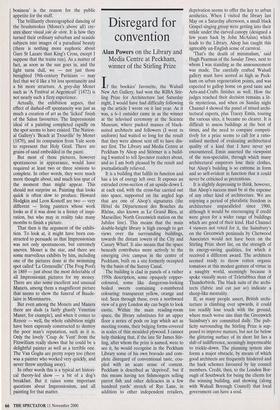Disregard for convention
Alan Powers on the Library and Media Centre at Peckham, winner of the Stirling Prize If the bookies' favourite, the Walsall New Art Gallery, had won the RIBA Stir- ling Prize for Architecture last Saturday night, I would have had difficulty following up the article I wrote on it last year. As it was, a 6-1 outsider came in as the winner at the televised ceremony at the Science Museum, where packed masses of black- suited architects and followers (I went in uniform) had waited so long for the result that they were almost sent off to have din- ner first. The Library and Media Centre at Peckham by Alsop and Stormer is a build- ing I wanted to tell Spectator readers about, and so I am both pleased by the result and journalistically relieved.
It is a building that fulfils its function and has a lot of energy left over. It exposes an extruded cross-section of an upside-down L at each end, with the cross-bar carried out into space, supported on the angled legs that are one of Alsop's signatures (the Hotel du Departement des Bouches du Rhone, also known as Le Grand Bleu, at Marseilles; North Greenwich station on the Jubilee line). This means that the main double-height library is high enough to get views over the surrounding buildings, towards the distant towers of the City and Canary Wharf. It also means that the space beneath contributes more actively to the emerging civic campus in the centre of Peckham, built on a site formerly occupied by the basin of the Surrey Canal.
The building is clad in panels of a rather 1950s description, some opaquely copper- coloured, some like dangerous-looking boiled sweets containing e-numbered colouring: transparent yellow, orange and red. Seen through these, even a northward view of a grey London sky can begin to look exotic. Within the main reading-room space, the library substitutes for an upper floor a series of pods on legs which act as meeting rooms, their bulging forms covered in scales of thin moulded plywood. I cannot help thinking that, if the late Sir James Stir- ling, after whom the prize is named, were to see it, he would recognise in the Peckham Library some of his own bravado and com- plete disregard of conventional taste, cou- pled with an acute sense of context. Peckham is described as 'deprived', but if this means having ten fishmongers selling parrot fish and other delicacies in a few hundred yards' stretch of Rye Lane, in addition to other independent retailers, deprivation seems to offer the key to urban aesthetics. When I visited the library last May on a Saturday afternoon, a small black Gospel singing group were getting into their stride under the curved canopy (designed a few years back by John McAslan) which leads to the Library. Alsop has caught this agreeably un-English sense of carnival.
`That's the death of minimalism,' said Hugh Pearman of the Sunday Times, next to whom I was standing as the announcement was made. The carefully crafted Walsall gallery must have scored as high as Peck- ham on urban regeneration points, and was expected to gallop home on good taste and Arts-and-Crafts finishes as well. How the judges reached their decision remains a lit- tle mysterious, and when on Sunday night Channel 4 showed the panel of mixed archi- tectural experts, plus Tracey Ernin, touring the various sites, it became no clearer. It is difficult to assess buildings at the best of times, and the need to compare competi- tively for a prize seems to call for a ratio- nalised method of evaluating architectural quality of a kind that I have never yet encountered. Emin asserted the viewpoint of the non-specialist, through which many architectural emperors lose their clothes, but Alsop's building is so extreme in form and so self-evident in function that it could never be criticised as pretentious.
It is slightly depressing to think, however, that Alsop's success must be at the expense of any other kind of architecture. We are enjoying a period of pluralistic freedom in architecture unparalleled since 1900, although it would be encouraging if credit were given for a wider range of buildings which are good of their kind. Had Channel 4 viewers not voted for it, the Sainsbury's on the Greenwich peninsula by Chetwood Associates would not have been on the Stirling Prize short list, on the strength of its energy-saving qualities, for which it received a different award. The architects seemed ready to throw rotten organic tomatoes at this modest gesture of virtue in a naughty world, seemingly because it spoke visually more of Teletubbies than of Thunderbirds. The black suits of the archi- tects (fabric and cut just so) indicate a sheep-like mentality.
If, as many people assert, British archi- tecture is climbing ever upwards, it could too readily lose touch with the ground, where much worse sins than the Greenwich Sainsbury's are committed daily. The pub- licity surrounding the Stirling Prize is sup- posed to improve matters, but not far below the glittering surface of its short list lies a slab of indifference, seemingly impermeable to trickle-down. The planning system also forms a major obstacle, by means of which good architects are frequently hindered and the hack schemes favoured by lay council members. Credit, then, to the London Bor- ough of Southwark for being the clients for the winning building, and showing (along with Walsall Borough Council) that local government can have a soul.


























































































 Previous page
Previous page